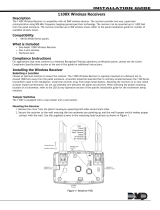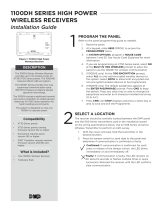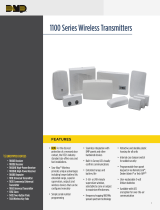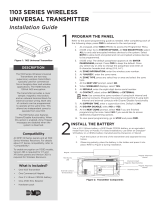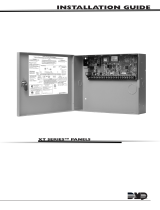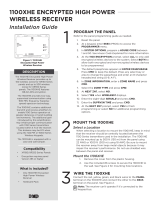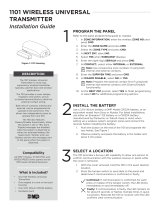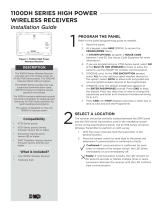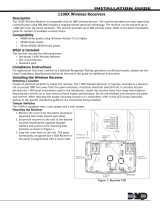Page is loading ...

INSTALLATION GUIDE
1102 Series
Wireless Universal Transmitter

1102 Installation Guide | Digital Monitoring Products 1
GET STARTED
The 1102 Universal Transmitter provides an onboard terminal block as a single input, typically used with external door
or window contacts. The contact operates as a single zone.
The 1102 features the Disarm/Disable operation to save battery life. When this option is enabled, Zone Tripped
messages are disabled when the system is disarmed.
Using the onboard LED, the transmitter provides built‑in survey capability to allow for single‑person installations,
eliminating the requirement for an external survey kit. For added security, an internal case tamper switch is provided.
What’s Included
▶One 1102 Transmitter
▶One 3 V lithium CR123A battery
▶Hardware pack
Compatibility
▶All DMP 1100 Series Wireless Receivers
▶All DMP XT Series and XR Series panels
Procedure
To install an 1102, this guide walks you through these required steps:
1. Program the panel.
2. Install the battery.
3. Use the LED Survey to select a location.
4. Mount the transmitter.
5. Wire external contacts.
6. Test the transmitter.
PCB Layout
Figure 1: 1102 Layout
External Contact
Terminal Block
Survey LED
Tamper Switch

1102 Installation Guide | Digital Monitoring Products 2
INSTALLATION
1 Program the Panel
Refer to the panel programming guide as needed. After completing each of the following steps, press CMD to
advance to the next prompt.
1. At a keypad, enter 6653 (PROG) to access the Programmer Menu.
2. At ZONE INFORMATION, enter the wireless zone number you would like to use (must begin in the 500
range when using XR panels).
3. At *UNUSED*, enter the zone name.
4. At ZONE TYPE, press any select key or area and select the zone type.
5. At the NEXT ZN? prompt, select NO.
6. When WIRELESS? displays, select YES.
7. At SERIAL#, enter the eight‑digit device serial number found on device packaging.
8. At CONTACT, select EXTERNAL.
9. At SUPRVSN TIME, enter a supervision time. Default is 240.
10. At DISARM DISABLE, select NO or YES.
11. At the NEXT ZONE prompt, select YES if you are finished programming the zone. Select NO if you would
like to access additional programming options.
12. To save panel programming, go to STOP and press CMD.
2 Install the Battery
Use a 3.0V lithium battery, a DMP Model CR123A battery, or an equivalent model from Sony or Murata. For listed
installations, use either an Energizer® 123battery or a CR123A battery manufactured by Panasonic or Tekcell.
1. Push the button on the end of the transmitterand separate the two halves.
2. Observing polarity, place the battery in the holder and press it into place. Refer to Figure 1during
installation.
Use the LED Survey to Select a Location
The transmitter provides a Survey LED capability to allow one person to confirm communication with the wireless
receiver or panel while the cover is removed.
1. With the cover removed, hold the transmitter in the exact desired location.
2. Press the tamper switch to send data to the panel and determine if communication is confirmed or faulty.
Confirmed: If communication is confirmed, for each press or release of the tamper switch the LED blinks
immediately on and immediately o. Repeat this test to confirm five separate consecutive LED blinks. Any
indication otherwise means proper communication has not been established.
Faulty: If communication is faulty, the LED remains on for about 8 seconds or flashes multiple times in
quick succession. Relocate the transmitter until the LED confirms clear communication.
3

1102 Installation Guide | Digital Monitoring Products 3
4
Mount the Transmitter
When mounting the 1102, refer to Figure 1for battery and mounting hole
locations.
1. Remove the battery and the PCB.
2. Place the supplied #4screw into the mounting hole and secure the
transmitter to the surface.
3. Reinsert the PCB and the battery.
4. Snap the transmitter cover back onto the base.
6
Test the Transmitter
After the transmitterhas been installed, test to confirm that it is communicating reliably with the panel. Use
the Tech APP™ to perform a Wireless Check‑in Test on the system or complete the following steps to perform a
Check‑in Test from a keypad that is connected to the panel. At the keypad, enter 8144 (WALK) and select WLS.
5 Wire External Contacts
Refer to Zone Information in the appropriate panel programming guide for more information. DMP recommends
using 18or 22AWG unshielded wire for contact connections. Do not use twisted pair or shielded wire.
1. Use a flathead screwdriver to loosen the two screws on the external contact terminal block.
2. Insert external contact wiring into the 1102terminal block and tighten the screws.
3. Connect the other ends of the wires to the external contact as either normally open (N/O) or normally
closed (N/C) without an end‑of‑line resistor.
4. Snap the transmitter cover back onto the base.
PCB Latch
Mounting
Screws
Figure 2: Mounting the Transmitter
External Contact
Terminal Block
1102
External
Contact
Magnet
Figure 3: External Contact Wiring

1102 Installation Guide | Digital Monitoring Products 4
ADDITIONAL INFORMATION
Supervision Time
When a receiver is installed, powered up, or the panel is reset, the supervision time for transmitters is reset. If the
receiver has been powered down for more than one hour, wireless transmitters may take up to an additional hour
to send a supervision message unless tripped, tampered, or powered up. This operation extends battery life for
transmitters. A missing message may display on the keypad until the transmitter sends a supervision message.
Replace the Battery
1. Push the button on the end of the transmitterand separate the two halves.
2. Remove the old battery, observe polarity, and place the new battery in the holder.
3. Snap the cover back on the transmitter.
Sensor Reset to Clear LOBAT
Once the battery is replaced, a sensor reset is required at the keypad to clear the LOBAT message. On an LCD keypad,
press and hold 2for two seconds. On a graphic touchscreen keypad, press RESET. Enter your user code, if required.
The keypad displays SENSORS OFF followed by SENSORS ON.

1102 Installation Guide | Digital Monitoring Products 5
SPECIFICATIONS
Battery
Life Expectancy 5 years (normal operation)
Type 3.0V lithium CR123A
Frequency Range 905‑924 MHz
Dimensions
Transmitter Case 3.3 L x 1.6 W x 0.9 H in.
Transmitter Base 3.3 L x 1.6 W x 0.1 H in.
Housing Material Flame retardant ABS
CERTIFICATIONS
▶FCC Part 15 Registration ID CCKPC0191
▶Industry Canada Registration ID 5251A‑PC0191
Underwriters Laboratory (UL) Listed
ANSI/ UL 1023 Household Burglar Alarm System Units Accessory Magnetically Activated Switch or Door
Contact Transmitter
ANSI/UL 634 Connections and Switches for use with Burglar Alarm Systems Accessory
Patents
U. S. Patent No. 7,239,236

18205
Designed, engineered, and
manufactured in Springfield, MO
using U.S. and global components.
LT-0701 1.04 21373
INTRUSION • FIRE • ACCESS • NETWORKS
2500 North Partnership Boulevard
Springfield, Missouri 65803-8877
800.641.4282 | DMP.com
© 2021
FCC Information
This device complies with Part 15 of the FCC Rules. Operation is subject to the following two conditions:
1. This device may not cause harmful interference, and
2. This device must accept any interference received, including interference that may cause undesired operation.
Changes or modifications made by the user and not expressly approved by the party responsible for compliance could void the user’s authority to
operate the equipment.
Note: This equipment has been tested and found to comply with the limits for a Class B digital device, pursuant to part 15 of the FCC Rules. These
limits are designed to provide reasonable protection against harmful interference in a residential installation. This equipment generates, uses and
can radiate radio frequency energy and, if not installed and used in accordance with the instructions, may cause harmful interference to radio
communications. However, there is no guarantee that interference will not occur in a particular installation. If this equipment does cause harmful
interference to radio or television reception, which can be determined by turning the equipment o and on, the user is encouraged to try to correct
the interference by one or more of the following measures:
• Reorient or relocate the receiving antenna.
• Increase the separation between the equipment and receiver.
• Connect the equipment into an outlet on a circuit dierent from that to which the receiver is connected.
• Consult the dealer or an experienced radio/TV technician for help.
Industry Canada Information
This device complies with Industry Canada License‑exempt RSS standard(s). Operation is subject to the following two conditions:
1. This device may not cause interference, and
2. This device must accept any interference, including interference that may cause undesired operation of the device.
Le présent appareil est conforme aux CNR d’Industrie Canada applicables aux appareils radio exempts de licence. L’exploitation est autorisée aux deux
conditions suivantes:
1. l’appareil ne doit pas produire de brouillage, et
2. l’utilisateur de l’appareil doit accepter tout brouillage radioélectrique subi, même si le brouillage est susceptible d’en compromettre le
fonctionnement.
/



